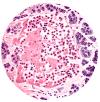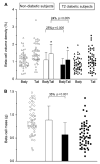The beta cell lesion in type 2 diabetes: there has to be a primary functional abnormality
- PMID: 19326096
- PMCID: PMC2737455
- DOI: 10.1007/s00125-009-1321-z
The beta cell lesion in type 2 diabetes: there has to be a primary functional abnormality
Abstract
The critical role of the beta cell in the pathogenesis of type 2 diabetes is now well established. When examined in patients with type 2 diabetes and individuals at increased risk, reductions in beta cell mass and abnormalities of beta cell function can both be demonstrated. The question of whether one alone is sufficient or both are necessary for the development of hyperglycaemia has been debated. Based on human and animal studies, it appears that neither alone is sufficient. Rather, for glucose to rise to the level at which diabetes would be diagnosed, defects in beta cell mass and in beta cell function are required.
Conflict of interest statement
The authors declare that they have no duality of interest.
Figures









References
-
- Reaven GM. Role of insulin resistance in human disease. Diabetes. 1988;37:1595–1607. - PubMed
-
- Kahn SE. The relative contributions of insulin resistance and beta-cell dysfunction to the pathophysiology of type 2 diabetes. Diabetologia. 2003;46:3–19. - PubMed
-
- Maclean N, Ogilvie RF. Quantitative estimation of the pancreatic islet tissue in diabetic subjects. Diabetes. 1955;4:367–376. - PubMed
-
- Kloppel G, Lohr M, Habich K, Oberholzer M, Heitz PU. Islet pathology and the pathogenesis of type 1 and type 2 diabetes mellitus revisited. Surv Synth Pathol Res. 1985;4:110–125. - PubMed
Publication types
MeSH terms
Substances
Grants and funding
LinkOut - more resources
Full Text Sources
Medical

